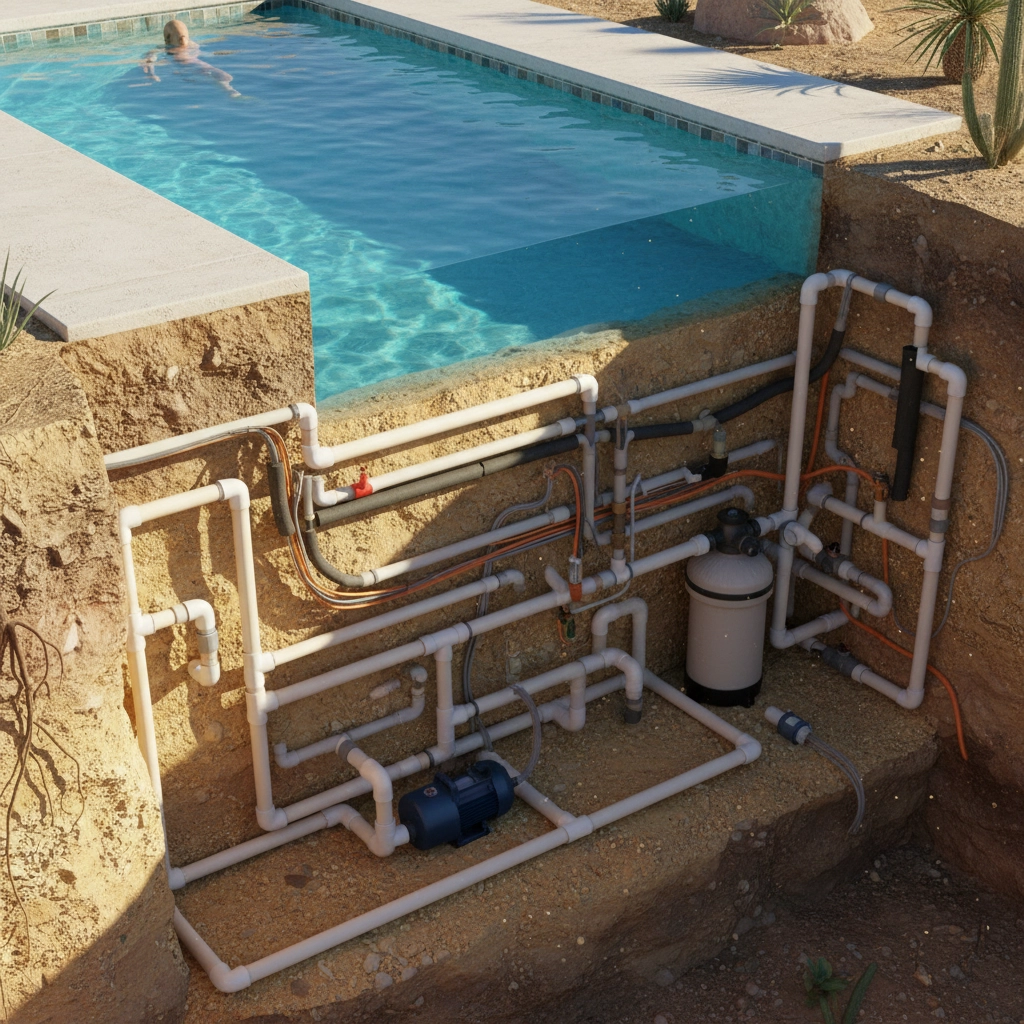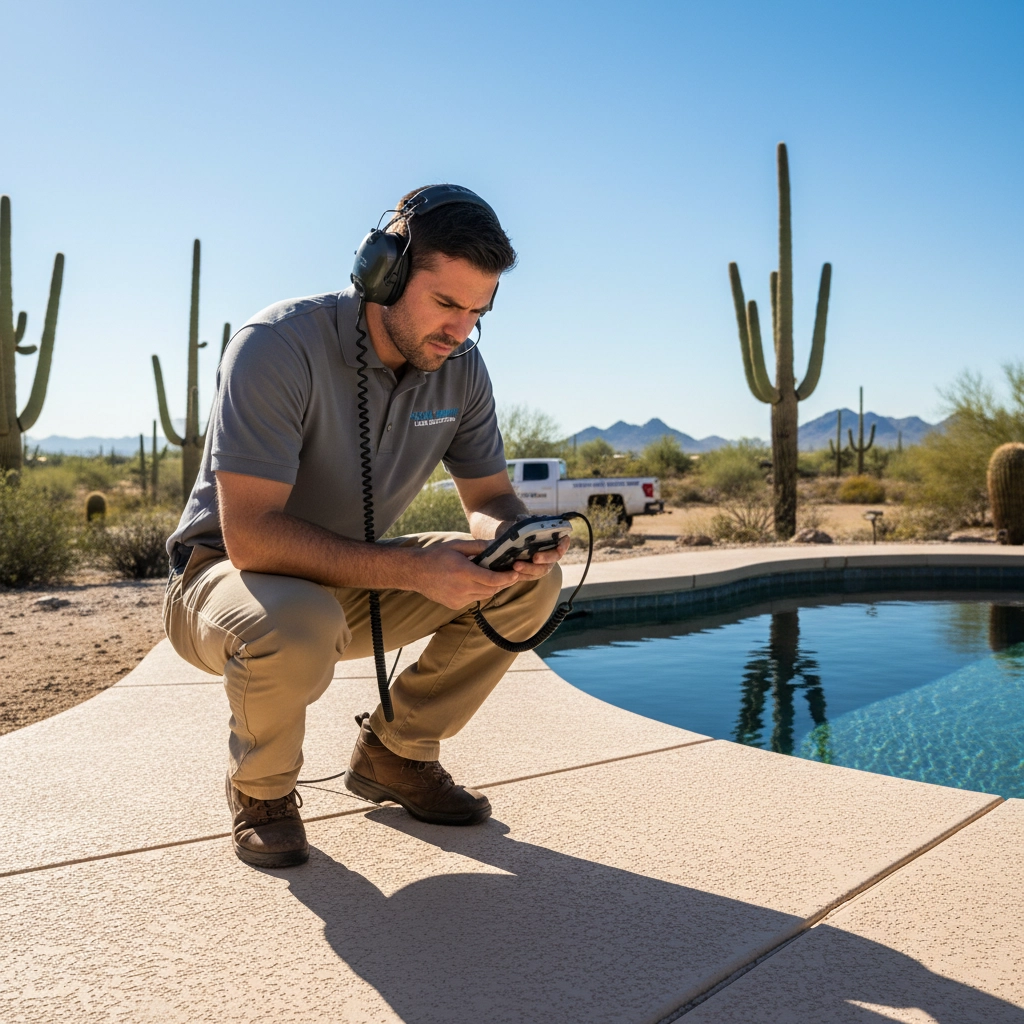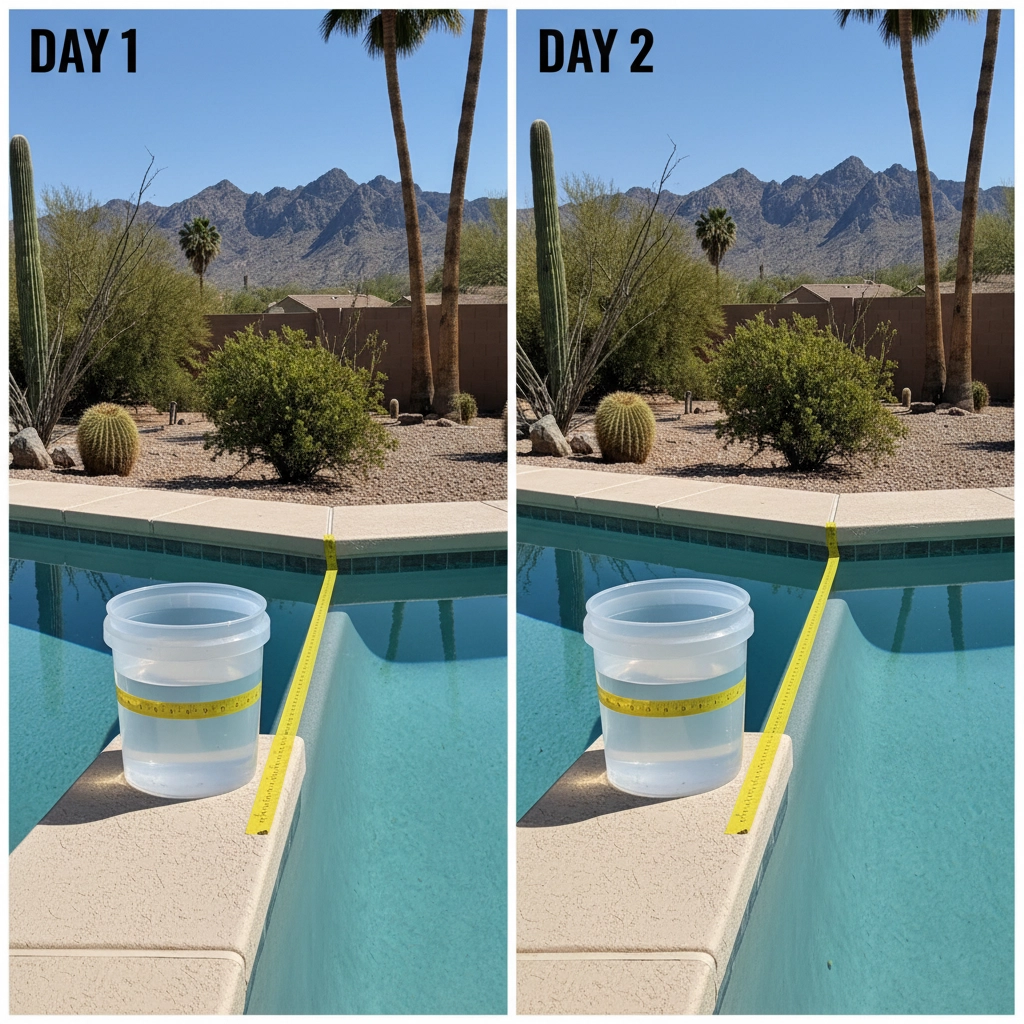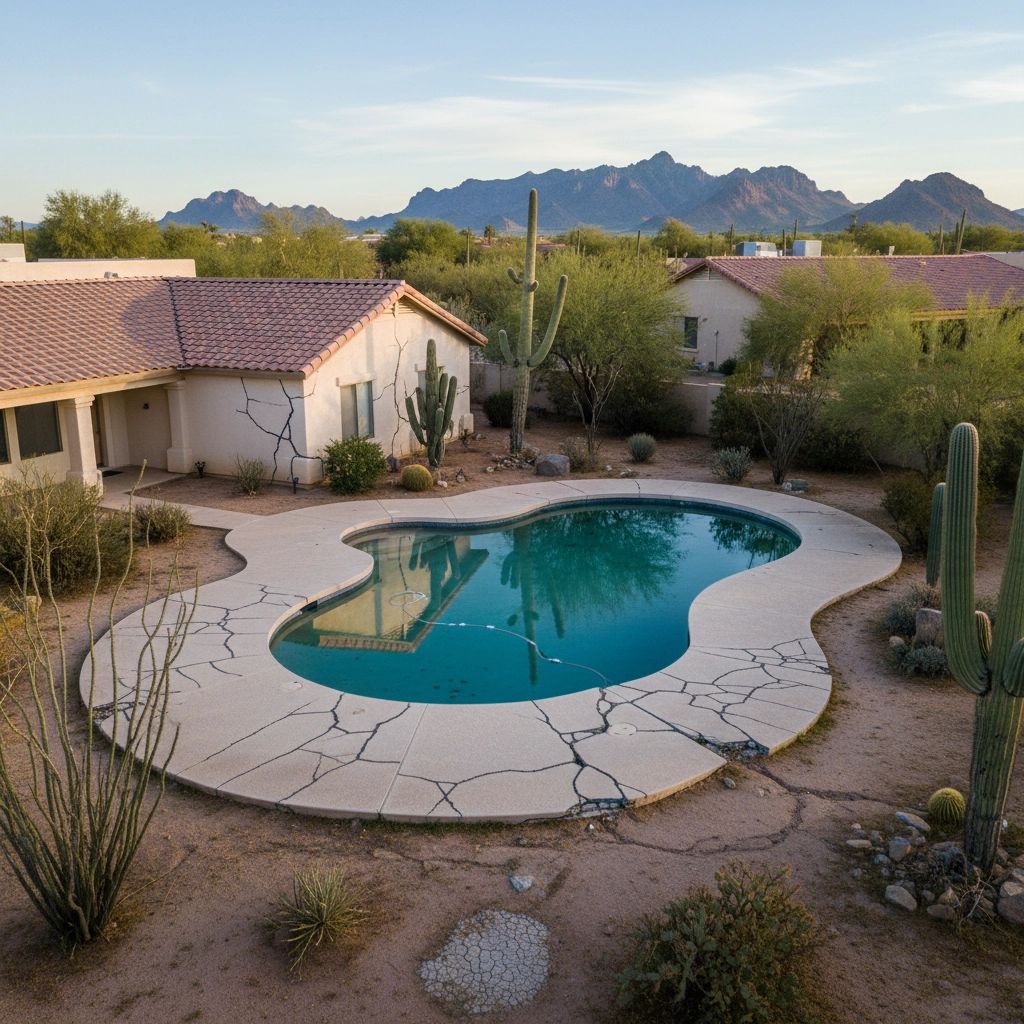You wake up one morning in Queen Creek, and your pool water level has dropped noticeably overnight. Again. Is it just Arizona's brutal heat causing evaporation, or do you have a leak hiding somewhere underground? If you're dealing with a persistent water loss problem in the East Valley, you're not alone – and the truth about underground leak detection might surprise you.
Why Arizona Pools Are Different (And Why That Matters for Leak Detection)
Before we dive into detection methods, let's talk about what makes pools in Mesa, Gilbert, Chandler, and San Tan Valley unique. Unlike pools in cooler climates, Arizona pools face some serious challenges that affect both how leaks develop and how they're detected.
First, Arizona pools typically feature plaster linings rather than vinyl. Why? Simple – vinyl liners can't handle our desert heat. They'd crack, warp, and fail within months. This construction difference means that many leak detection techniques designed for vinyl-lined pools simply don't work here.
Second, our extreme temperatures create rapid evaporation. During summer months, it's completely normal for pools to lose 1-2 inches of water per week just from evaporation. This natural water loss can mask actual leaks, making it harder to distinguish between normal evaporation and a real problem.

The Underground Challenge: Why These Leaks Are Tricky
Underground pool leaks are particularly sneaky because they often don't leave obvious clues. Unlike a crack in your pool's visible surface, underground leaks happen in buried plumbing lines, around skimmers, or beneath your pool shell. The water simply disappears into Arizona's thirsty desert soil.
Here's what makes underground leaks especially challenging in our climate:
- Desert soil conditions can quickly absorb leaked water, leaving no wet spots as evidence
- High temperatures cause any surface moisture to evaporate rapidly
- Concrete pool decks hide underground pipe locations, making visual inspection impossible
- Multiple plumbing lines create numerous potential leak points
Professional Detection Methods That Actually Work in Desert Heat
Pressure Testing: The Gold Standard
Professional leak detection companies across the East Valley use pressure testing as their primary method for finding underground leaks. Here's how it works in simple terms:
Think of your pool's plumbing system like a garden hose. When you turn on the water, pressure builds up throughout the system. If there's a hole anywhere – even a tiny one – that pressure will drop.
Technicians isolate different sections of your pool's plumbing and introduce pressurized air or water. They monitor for pressure drops, and even a small decrease of 1-2 PSI signals a leak in that specific section. This method works regardless of how deep the pipes are buried or how hot it is outside.
Acoustic Detection: Listening for the Problem
This might sound like something from a spy movie, but acoustic leak detection is incredibly effective for underground leaks in Gilbert and Chandler pools. Professional technicians use specialized listening devices that can detect the sound of escaping air or water through underground pipes.
The process starts by introducing pressurized air into the suspected pipe section. Then, using sensitive acoustic sensors and specialized headphones, technicians literally listen for the distinctive sound of air escaping through cracks or breaks.
By slowly walking along the suspected pipe's path, they can pinpoint the exact leak location and mark an "X" on your deck. This precision often means excavating just a small 3×3 foot area instead of tearing up your entire backyard.

Infrared Detection: Seeing What's Hidden
Thermal imaging technology offers another sophisticated approach that works particularly well in Arizona's climate. Infrared cameras detect temperature differences created by escaping water, showing hot and cold spots around your pool area that indicate leak locations.
This method excels at finding leaks in challenging spots:
- Under concrete pool decks
- Behind retaining walls
- Inside underground plumbing
- Beneath the pool shell itself
While infrared detection typically costs $400-800, it prevents expensive excavation work by precisely locating leaks before any digging begins.
DIY Detection: The Bucket Test for Arizona Pools
Despite our challenging climate, Queen Creek and San Tan Valley homeowners can still perform basic leak detection using the tried-and-true bucket test. This simple method helps distinguish between evaporation and actual leaks.
Here's your step-by-step guide:
- Fill a 5-gallon bucket with your pool water
- Place it on your pool's second step (or use a weight to keep it stable)
- Mark both water levels – inside the bucket and your pool's water level – using waterproof markers or tape
- Turn off all pool equipment to eliminate interference
- Wait 24 hours and check both levels
Reading the results:
- If both levels drop equally = you're dealing with evaporation (totally normal in Arizona)
- If your pool level drops more than the bucket = you likely have a leak
Pro tip: Repeat the test with your pool equipment running. If the water loss increases significantly, the leak might be in your filtration system rather than the pool structure itself.

When Underground Leaks Require Professional Help
While the bucket test helps identify whether you have a leak, finding underground leaks requires professional equipment and expertise. Here's why DIY detection has its limits:
Equipment limitations: Consumer-grade tools simply can't detect leaks several feet underground through concrete and desert soil.
Safety concerns: Excavating around electrical lines, gas pipes, or structural elements requires professional knowledge.
Accuracy matters: Guessing at leak locations can lead to expensive, unnecessary excavation and property damage.
The Real Cost of Ignoring Underground Leaks
Some Mesa and Chandler homeowners think they can live with a small underground leak, especially if it's not dramatically affecting their water bill. This thinking can be costly:
Structural damage: Leaked water can undermine your pool's foundation, deck stability, and surrounding landscaping.
Utility costs: Even small leaks waste thousands of gallons annually, adding up on your water bill.
Chemical waste: Constantly adding fresh water dilutes your pool chemicals, requiring more frequent and expensive chemical adjustments.
Equipment strain: Your pool pump works harder to maintain proper circulation when water levels drop, leading to premature equipment failure.
Choosing the Right Detection Service in the East Valley
When selecting a leak detection service in Gilbert, Mesa, or surrounding areas, look for companies that:
- Use multiple detection methods (pressure testing, acoustic, and infrared)
- Provide written reports with exact leak locations
- Offer guarantees on their detection accuracy
- Have experience with Arizona's unique pool construction
- Can coordinate repairs without additional excavation

Prevention: Protecting Your Investment
While not all underground leaks are preventable, regular maintenance can catch problems early:
Schedule annual inspections of visible plumbing connections and fittings. Small issues often indicate bigger problems developing underground.
Monitor water levels consistently. Sudden changes in water loss patterns often signal new leak development.
Maintain proper water chemistry. Corrosive water conditions accelerate pipe deterioration, leading to underground leaks.
Address minor repairs promptly. Small visible cracks or loose fittings can indicate stress on underground components.
The Bottom Line on Arizona Pool Leak Detection
Underground leak detection in Arizona requires understanding our unique challenges – from extreme heat to desert soil conditions to specialized pool construction. While basic tests like the bucket method help identify whether you have a leak, pinpointing underground problems requires professional equipment and expertise.
The truth is, modern detection technology combined with experienced local technicians can locate even the most elusive underground leaks with minimal property disruption. When you're dealing with persistent water loss in your Queen Creek, San Tan Valley, Mesa, Gilbert, or Chandler pool, professional detection services aren't just convenient – they're essential for protecting your investment and avoiding costly damage.
Don't let an underground leak turn into a major headache. Understanding the detection process helps you make informed decisions and work effectively with professionals to solve the problem quickly and efficiently.


0 Comments